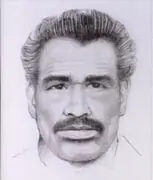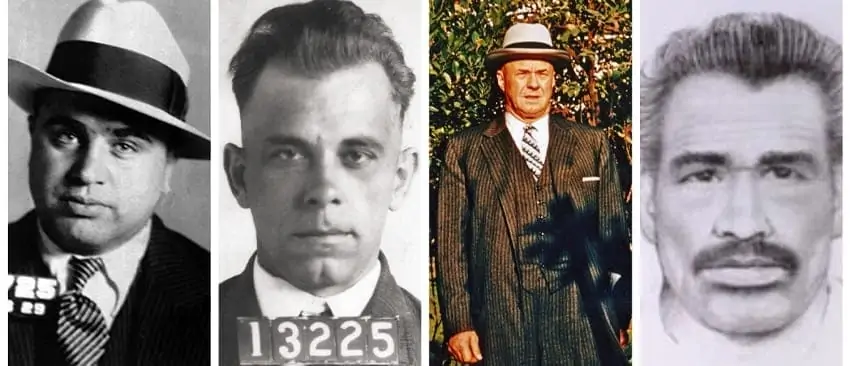Organized Crime on the North Shore
The North Shore of Lake Superior and areas up the Gunflint Trail served as a “secret hideaway” for many notorious Chicago-area gangsters of the 1920s and 30s. The area was also home to one of the most prolific bank robbers in US history. Being so far north, far away from major cities, and with Lake Superior in its backyard, the North Shore was the perfect place for making moonshine, running illegal liquor, and just a great place in general for someone to hide out, when needed.
Al Capone and the Lutsen Resort Fish House
 From “Lutsen Resort History”: Gangsters from Chicago found Lutsen to be a great “getaway,” including Baby-Face Nelson, John Dillinger, and Al Capone. Capone arrived with his “wife” and requested a more remote spot than the lodge. They were offered a fish house two miles away, and when it was discovered that the fish house was riddled with bullet holes, the owners demanded, and received, $20 extra from Capone.
From “Lutsen Resort History”: Gangsters from Chicago found Lutsen to be a great “getaway,” including Baby-Face Nelson, John Dillinger, and Al Capone. Capone arrived with his “wife” and requested a more remote spot than the lodge. They were offered a fish house two miles away, and when it was discovered that the fish house was riddled with bullet holes, the owners demanded, and received, $20 extra from Capone.
So what was Al Capone doing that required a remote place to stay? Sure, he came up with his mistress (I’m assuming) and probably wanted some privacy for her. But what else went on in that fish house? From the story, it doesn’t appear anyone was injured or “offed” during Capone’s stay. But one has to wonder why he’d shoot the place up. “Riddled with bullets” implies more than just a couple of one-off gunshots. Perhaps he got a bit trigger happy after having a few? But, hey, props to Capone for handing over the $20, right?
It is also said that Al Capone was a frequent visitor to Illgen City’s resort. He and other well-known gangsters of the time would often stop by and spend a few nights before continuing on to “secret” Northern Resorts.
The Naniboujou Social Club
 In 1927, construction on a private club on Minnesota’s North Shore began. Funded by the rich and elite from Minneapolis, Chicago, and other midwestern cities. The Naniboujou Social Club opened its doors to a select few who were “in the know” in 1928. The social club catered to a few well-known guests, including famous names of time like Babe Ruth and Jack Dempsey. It was also a popular destination for those mobsters from Chicago that needed a quiet place to rest for a little while. Al Capone and John Dillinger are said to have been frequent visitors. Usually, when someone references a “secret North Shore resort” where gangsters and their associates would hideout, they are usually referring to the Naniboujou Social Club. Although there were several others in the area during this time, Naniboujou was the most popular and most well-known today.
In 1927, construction on a private club on Minnesota’s North Shore began. Funded by the rich and elite from Minneapolis, Chicago, and other midwestern cities. The Naniboujou Social Club opened its doors to a select few who were “in the know” in 1928. The social club catered to a few well-known guests, including famous names of time like Babe Ruth and Jack Dempsey. It was also a popular destination for those mobsters from Chicago that needed a quiet place to rest for a little while. Al Capone and John Dillinger are said to have been frequent visitors. Usually, when someone references a “secret North Shore resort” where gangsters and their associates would hideout, they are usually referring to the Naniboujou Social Club. Although there were several others in the area during this time, Naniboujou was the most popular and most well-known today.
 The Great Depression led to Naniboujou’s closure in 1935 and the clubhouse was shuttered for several years. It later reopened as a public lodge and resort that is still in operation today. You can head up to the resort, located near the Brule River just outside Hovland, for an incredible Sunday Brunch or Afternoon Tea. It’s ties to the mob were relatively short-lived, but remains notorious local lore.
The Great Depression led to Naniboujou’s closure in 1935 and the clubhouse was shuttered for several years. It later reopened as a public lodge and resort that is still in operation today. You can head up to the resort, located near the Brule River just outside Hovland, for an incredible Sunday Brunch or Afternoon Tea. It’s ties to the mob were relatively short-lived, but remains notorious local lore.
Interestingly, John Dillinger is noted as being a frequent visitor to Naniboujou and his name has been in the news recently- On October 4th, 2019, the Indiana State Department of Health gave permission for Dillinger relatives to dig up and then rebury Dillinger’s body. The family does not believe that the body buried in Dillinger’s grave is his. As police reports from his fatal shooting in 1934 in front of a Chicago movie theater describes a man with a different eye color. And fingerprints taken post-mortem do not match those known to belong to Dillinger. The exhumation is scheduled for December 31st.
Tommy Banks
 In the 1940s and 50s, Tommy Banks made a fortune running bars and liquor stores in the Minneapolis/St. Paul area, despite being a convicted felon which should have prohibited him from owning an alcohol business. Before that, during Prohibition, Tommy Banks operated The Syndicate, supplying alcohol to Minneapolis bars. Despite being connected to several high-profile murders and, of course, running alcohol during Prohibition, Tommy Banks was never convicted or even tried, for these crimes. Instead, much like Al Capone, authorities got him in a 1937 charge of tax fraud.
In the 1940s and 50s, Tommy Banks made a fortune running bars and liquor stores in the Minneapolis/St. Paul area, despite being a convicted felon which should have prohibited him from owning an alcohol business. Before that, during Prohibition, Tommy Banks operated The Syndicate, supplying alcohol to Minneapolis bars. Despite being connected to several high-profile murders and, of course, running alcohol during Prohibition, Tommy Banks was never convicted or even tried, for these crimes. Instead, much like Al Capone, authorities got him in a 1937 charge of tax fraud.
Tommy’s connection to the North Shore can be found on the Gunflint Trail. Tommy owned a cabin located on Hungry Jack Lake. It was a part of Hungry Jack Lodge and maintained by Bill Needham, a Gunflint Trail local who formed an “unlikely friendship” with Tommy Banks. This friendship was the basis of the display at Chik-Wauk Museum during the summer of 2019.
Unlike other Mobsters, Tommy Banks ended up living a long life. He died in 1985 at the age of 91 from heart disease.
Hear more about Tommy Banks and his connection to Hungry Jack Lodge in this 2016 report by WTIP’s Joe Friedrichs:
The Trench Coat Bank Robbers
 “The Trenchcoat Robbers” were a pair of bank robbers named William A. Kirkpatrick and Ray A. Bowman. The pair had been meticulously robbing banks all over the US starting with a 1982 robbery in Annapolis, MO. Their heists included pulling off the largest bank robbery in U.S. history. On February 10th, 1997 they robbed Seafirst Bank newar Tacoma, WA, netting $4,461,681 cash they carried out in bags that weighed 355 pounds. In total, they robbed 28 banks and made off with over $8 million in cash between 1982 and 1997.
“The Trenchcoat Robbers” were a pair of bank robbers named William A. Kirkpatrick and Ray A. Bowman. The pair had been meticulously robbing banks all over the US starting with a 1982 robbery in Annapolis, MO. Their heists included pulling off the largest bank robbery in U.S. history. On February 10th, 1997 they robbed Seafirst Bank newar Tacoma, WA, netting $4,461,681 cash they carried out in bags that weighed 355 pounds. In total, they robbed 28 banks and made off with over $8 million in cash between 1982 and 1997.
They were careful and meticulous, spending months planning a heist. They never robbed banks close to home. Then, once the robbery was completed, the two would part ways and return to their perspective homes in different states to avoid being connected to one another. Bowman would return home to Kansas City, MO while William Kirkpatrick headed north- to the tiny town of Hovland, Minnesota.
 It was a cash exchange in Hovland in 1996 that finally put the Trench Coat Robber’s on the FBI radar. Kirkpatrick had given his girlfriend, a woman named Myra Penney, $188,000 cash to pay for a newly constructed log cabin. It was the builder, a man named Michael Senty, who found this amount of cash to be suspicious and reported the payment to the IRS after having an argument with Penney. After not being able to verify income for either Penney or Kirkpatrick, who had assumed the alias Donald Wilson, the IRS alerted the FBI, and the heat was on.
It was a cash exchange in Hovland in 1996 that finally put the Trench Coat Robber’s on the FBI radar. Kirkpatrick had given his girlfriend, a woman named Myra Penney, $188,000 cash to pay for a newly constructed log cabin. It was the builder, a man named Michael Senty, who found this amount of cash to be suspicious and reported the payment to the IRS after having an argument with Penney. After not being able to verify income for either Penney or Kirkpatrick, who had assumed the alias Donald Wilson, the IRS alerted the FBI, and the heat was on.
Though that was the initial tipping point, a few other mistakes were made by the pair along the way. Around the same time that Senty was making his report to the IRS, a mini-storage owner was contacting the authorities after finding a cache of firearms in a storage unit in Missouri that Bowman had failed to make a payment on. Kirkpatrick had also been pulled over in Nebraska for going 7 mph over the speed limit on his way home from collecting money he had stashed in a Las Vegas storage locker. He had given the officer his fake ID. Suspecting it was a fake ID, the officer searched his car and found guns, a ski mask, as well as other disguises, and $1.8 million cash. Kirkpatrick was arrested and the FBI was able to connect Bowman and Kirkpatrick together as the Trench Coat Robbers.
In 1998, about a year after the Seafirst Bank robbery, Bowman and Kirkpatrick were indited by a federal grand jury. After being urged by Penney to admit to his crimes, Kirkpatrick plead guilty to three bank robberies. He received a 15-year, 8-month sentence. He was only charged with three as the statute of limitations had run out on other robberies. Kirkpatrick has since served his sentence and has been released. Bowman continued to deny his connection to the Trench Coat Robbers and took his case to court. He was found guilty of four bank robberies and was given a 24-year, 6-month sentence. I could not find confirmation as to whether Bowman was still in prison or if he, too, has been released.
The two were featured in a 1992 episode of Unsolved Mysteries.
So whether the area was used as a hideaway or for actively producing moonshine during prohibition, its appeal to these notorious leaders of organized crime is what brings many visitors to the area today. Well, perhaps not the moonshine part. Prohibition in the United States ended in 1933 and liquor is available in liquor stores and restaurants, but the desire for a quiet escape still rings true for many. Even if it’s just the need to escape from the hustle and bustle of real life.

